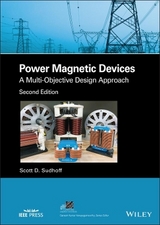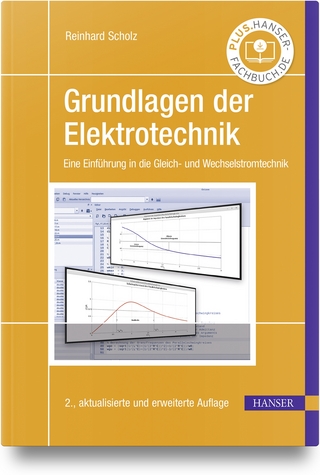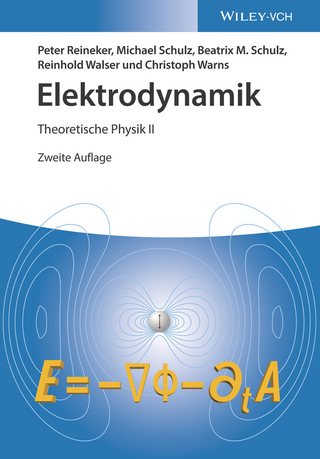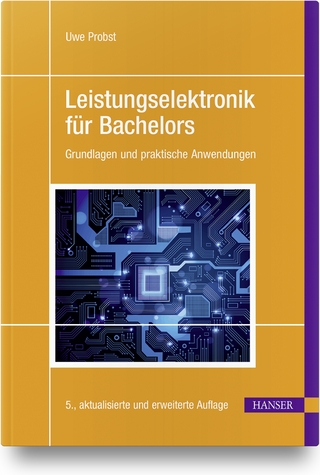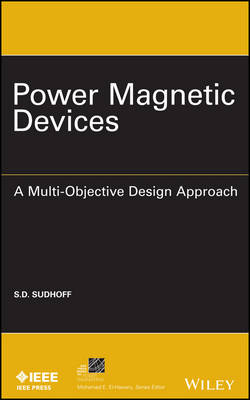
Power Magnetic Devices
John Wiley & Sons Inc (Verlag)
978-1-118-48999-4 (ISBN)
- Titel erscheint in neuer Auflage
- Artikel merken
Presents a multi-objective design approach to the many power magnetic devices in use today Power Magnetic Devices: A Multi-Objective Design Approach addresses the design of power magnetic devices including inductors, transformers, electromagnets, and rotating electric machinery using a structured design approach based on formal single- and multi-objective optimization. The book opens with a discussion of evolutionary-computing-based optimization. Magnetic analysis techniques useful to the design of all the devices considered in the book are then set forth. This material is then used for inductor design so readers can start the design process. Core loss is next considered; this material is used to support transformer design. A chapter on force and torque production feeds into a chapter on electromagnet design. This is followed by chapters on rotating machinery and the design of a permanent magnet AC machine. Finally, enhancements to the design process including thermal analysis and AC conductor losses due to skin and proximity effects are set forth.
Power Magnetic Devices: * Focuses on the design process as it relates to power magnetic devices such as inductors, transformers, electromagnets, and rotating machinery * Offers a structured design approach based on single- and multi-objective optimization * Helps experienced designers take advantage of new techniques which can yield superior designs with less engineering time * Provides numerous case studies throughout the book to facilitate readers comprehension of the analysis and design process * Includes Powerpoint-slide-based student and instructor lecture notes and MATLAB-based examples, toolboxes, and design codes Designed to support the educational needs of students, Power Magnetic Devices: A Multi-Objective Design Approach also serves as a valuable reference tool for practicing engineers and designers. MATLAB examples are available via the book support site.
S.D. SUDHOFF is a Professor of Electrical and Computer Engineering at Purdue University. He served as Editor-in-Chief of IEEE s Transactions on Energy Conversion and is the inaugural Editor-in-Chief of IEEE s Power and Energy Technology Systems Journal. He is an IEEE Fellow, recipient of the Veinott award, coauthor of Analysis of Electric Machinery and Drive Systems, Third Edition (Wiley-IEEE Press), and has authored or coauthored over one hundred journal and conference papers, including six prize papers. Dr. Sudhoff also holds patents in the areas of solid-state distribution transformers and the stability of power electronics-based systems.
PREFACE XI CHAPTER 1 OPTIMIZATION-BASED DESIGN 1 1.1 Design Approach 1 1.2 Mathematical Properties of Objective Functions 3 1.3 Single-Objective Optimization Using Newton's Method 5 1.4 Genetic Algorithms: Review of Biological Genetics 8 1.5 The Canonical Genetic Algorithm 11 1.6 Real-Coded Genetic Algorithms 16 1.7 Multi-Objective Optimization and the Pareto-Optimal Front 27 1.8 Multi-Objective Optimization Using Genetic Algorithms 30 1.9 Formulation of Fitness Functions for Design Problems 34 1.10 A Design Example 36 CHAPTER 2 MAGNETICS AND MAGNETIC EQUIVALENT CIRCUITS 45 2.1 Ampere's Law, Magnetomotive Force, and Kirchhoff's MMF Law for Magnetic Circuits 46 2.2 Magnetic Flux, Gauss's Law, and Kirchhoff's Flux Law for Magnetic Circuits 49 2.3 Magnetically Conductive Materials and Ohm's Law for Magnetic Circuits 51 2.4 Construction of the Magnetic Equivalent Circuit 61 2.5 Translation of Magnetic Circuits to Electric Circuits: Flux Linkage and Inductance 64 2.6 Representing Fringing Flux in Magnetic Circuits 70 2.7 Representing Leakage Flux in Magnetic Circuits 75 2.8 Numerical Solution of Nonlinear Magnetic Circuits 88 2.9 Permanent Magnet Materials and Their Magnetic Circuit Representation 104 2.10 Finite Element Analysis 108 CHAPTER 3 INTRODUCTION TO INDUCTOR DESIGN 113 3.1 Common Inductor Architectures 113 3.2 DC Coil Resistance 115 3.3 DC Inductor Design 118 3.4 Case Study 125 3.5 Closing Remarks 131 CHAPTER 4 FORCE AND TORQUE 133 4.1 Energy Storage in Electromechanical Devices 133 4.2 Calculation of Field Energy 135 4.3 Force from Field Energy 138 4.4 Co-Energy 139 4.5 Force from Co-Energy 143 4.6 Conditions for Conservative Fields 144 4.7 Magnetically Linear Systems 145 4.8 Torque 147 4.9 Calculating Force Using Magnetic Equivalent Circuits 148 CHAPTER 5 INTRODUCTION TO ELECTROMAGNET DESIGN 154 5.1 Common Electromagnet Architectures 154 5.2 Magnetic, Electric, and Force Analysis of an EI-Core Electromagnet 155 5.3 EI-Core Electromagnet Design 165 5.4 Case Study 171 CHAPTER 6 MAGNETIC CORE LOSS 178 6.1 Eddy Current Losses 178 6.2 Hysteresis Loss and the B H Loop 186 6.3 Empirical Modeling of Core Loss 191 6.4 Time Domain Modeling of Core Loss 197 CHAPTER 7 TRANSFORMER DESIGN 205 7.1 Common Transformer Architectures 205 7.2 T-Equivalent Circuit Model 207 7.3 Steady-State Analysis 211 7.4 Transformer Performance Considerations 213 7.5 Core-Type Transformer Configuration 223 7.6 Core-Type Transformer MEC 230 7.7 Core Loss 236 7.8 Core-Type Transformer Design 238 7.9 Case Study 245 7.10 Closing Remarks 252 CHAPTER 8 DISTRIBUTED WINDINGS AND ROTATING ELECTRIC MACHINERY 254 8.1 Describing Distributed Windings 254 8.2 Winding Functions 265 8.3 Air-Gap Magnetomotive Force 268 8.4 Rotating MMF 272 8.5 Flux Linkage and Inductance 273 8.6 Slot Effects and Carter's Coefficient 276 8.7 Leakage Inductance 278 8.8 Resistance 283 8.9 Introduction to Reference Frame Theory 284 8.10 Expressions for Torque 290 CHAPTER 9 INTRODUCTION TO PERMANENT MAGNET AC MACHINE DESIGN 299 9.1 Permanent Magnet Synchronous Machines 299 9.2 Operating Characteristics of PMAC Machines 301 9.3 Machine Geometry 309 9.4 Stator Winding 315 9.5 Material Parameters 318 9.6 Stator Currents and Control Philosophy 319 9.7 Radial Field Analysis 320 9.8 Lumped Parameters 325 9.9 Ferromagnetic Field Analysis 327 9.10 Formulation of Design Problem 333 9.11 Case Study 339 9.12 Extensions 346 CHAPTER 10 INTRODUCTION TO THERMAL EQUIVALENT CIRCUITS 349 10.1 Heat Energy, Heat Flow, and the Heat Equation 349 10.2 Thermal Equivalent Circuit of One-Dimensional Heat Flow 352 10.3 Thermal Equivalent Circuit of a Cuboidal Region 359 10.4 Thermal Equivalent Circuit of a Cylindrical Region 363 10.5 Inhomogeneous Regions 370 10.6 Material Boundaries 377 10.7 Thermal Equivalent Circuit Networks 379 10.8 Case Study: Thermal Model of Electromagnet 385 CHAPTER 11 AC CONDUCTOR LOSSES 403 11.1 Skin Effect in Strip Conductors 403 11.2 Skin Effect in Cylindrical Conductors 410 11.3 Proximity Effect in a Single Conductor 414 11.4 Independence of Skin and Proximity Effects 416 11.5 Proximity Effect in a Group of Conductors 418 11.6 Relating Mean-Squared Field and Leakage Permeance 422 11.7 Mean-Squared Field for Select Geometries 423 11.8 Conductor Losses in Rotating Machinery 428 11.9 Conductor Losses in a UI-Core Inductor 432 11.10 Closing Remarks 436 References 437 Problems 437 APPENDIX A CONDUCTOR DATA AND WIRE GAUGES 439 APPENDIX B SELECTED FERRIMAGNETIC CORE DATA 441 APPENDIX C SELECTED MAGNETIC STEEL DATA 443 APPENDIX D SELECTED PERMANENT MAGNET DATA 445 APPENDIX E PHASOR ANALYSIS 446 APPENDIX F TRIGONOMETRIC IDENTITIES 453 INDEX 455
| Erscheint lt. Verlag | 8.4.2014 |
|---|---|
| Reihe/Serie | IEEE Press Series on Power and Energy Systems |
| Verlagsort | New York |
| Sprache | englisch |
| Maße | 161 x 250 mm |
| Gewicht | 860 g |
| Themenwelt | Naturwissenschaften ► Physik / Astronomie ► Elektrodynamik |
| Technik ► Elektrotechnik / Energietechnik | |
| Technik ► Maschinenbau | |
| ISBN-10 | 1-118-48999-3 / 1118489993 |
| ISBN-13 | 978-1-118-48999-4 / 9781118489994 |
| Zustand | Neuware |
| Informationen gemäß Produktsicherheitsverordnung (GPSR) | |
| Haben Sie eine Frage zum Produkt? |
aus dem Bereich
